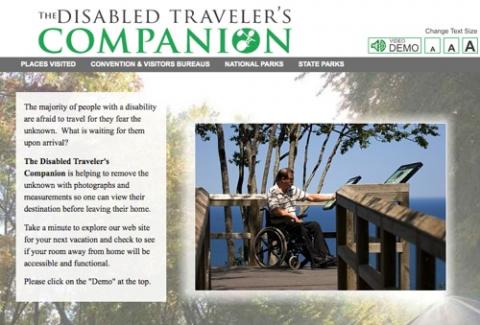Let's face it, the National Park Service is making strides in addressing ADA needs, but has a ways to go. One couple that frequently travels to parks is making it easier for disabled travelers to anticipate what their visits will be like through websites that assess individual park's accessibility factors.
Through their Disabled Traveler's Companion, Ron and Kay Wilmers look at various aspects of a park -- campgrounds, trails, backcountry sites, lodging, transportation -- and assess them in terms of accessibility for disabled travelers.
"The goal of The Disabled Traveler's Companion is to remove much of the unknown in our national parks that concerns visitors with a disability," the Wilmers say in a message on their site. "By condensing and focusing accessible areas of the parks to one website, a visitor with a disability will be able to better prepare themselves for an experience they will cherish and talk about forever, especially with their children or grandchildren."
So far the Wilmers have produced accessibility information on Rocky Mountain and Glacier national parks, and Pictured Rocks and Sleeping Bear Dunes national lakeshores.
At Rocky Mountain, for instance, they note that "most facilities are marginally accessible or better." They also provide a rundown of accessible trails, accessible backcountry campsites, and a breakdown of front-country campgrounds and their accessibility features. Their site also provides photographs of these areas, so if you're relying on a wheelchair or cane to get around you'll be able to see what you'll encounter when you reach the park.
One example of their thoroughness is that they even explore restrooms for ADA compliance, and provide a rundown on ADA transportation.
At Sleeping Bear Dunes they go throughout the national lakeshore to measure its accessibility achievements. One page looks at the boardwalks to the Dune Overlook, another touches on the North Bar Overlook and Picnic Area, and yet another shows that while there is a boardwalk leading to the Lake Michigan Overlook, sand can be blown across the boardwalk in places at times.
The section on Glacier also includes information on accessible lodging in the park.
All-in-all, the Wilmers have put together a great resource for disabled travelers, one that hopefully will continue to grow park by park.
Kay Wilmers is a registered nurse with both hospital and home health care experience. After years of being involved in the daily lives of people in health recovery, she decided to do more to help open doors for people with disabilities who like to travel.
Kay with her nursing background and travel experiences with her husband, sons, and grandsons, decided to pursue the exciting concept of travel for people with disabilities. Her family has traveled throughout the United States, with overnight stays in some very unique places. Their lodgings have ranged from hotels to tents in a campsite in the national parks. Through the years Kay saw changes regarding accessibility ... new laws were being implemented to meet the travel needs of people with disabilities. But she discovered that much of this information was not getting into the hands of the people who could benefit from it the most - travelers with disabilities. Kay found that researching trips and telephone calls to travel locations never gave enough information about whether Ron's functional needs would be met. To address this issue, Kay started "The Disabled Traveler's Companion," a web site company geared toward providing specific information for people with disabilities so they may go where everyone else has gone before.
Ron has been in a wheelchair since 1977. He has experienced the many changes that have occurred for people with disabilities.




Comments
I have had the pleasure of knowing Kay and Ron for 15 years or so now. Their mission is awesome! They want to take the fear out of travel for the disabled community and anyone with any type of restriction or limitation. We have enjoyed learning how we in the hotel business can do a better job of sharing facts with our guests. They are giving us tools to make it easier with our staff and clear to the traveling public! Yeah Wilmers and Yeah National Parks folks for recognizing our duty to make traveling easier for everyone!
I broke my leg last year and we had several trips to National Parks planned for the summer. All of a sudden I found myself needing to be concerned with accessiblity issues - something I had never had to think about before. It was a brand new experience for me and the good part of it was that I saw the world from a different point of view and gained a lot of sensitivites to the needs of disabled. I'm glad to see such a great book out that will encourage people to still get out and visit our National Parks!
Providing disabled individuals a good guide (Disabled Traveler's Companion) in visiting parks is not only about patronization of these parks but also in essence a display of special concern to disabled individuals who also deserve to have a chance to visit and appreciate these parks.
Do you have a list of handicapped accessible parks in Florida?